
Different Types of Table Tennis Grips
Table tennis is a racket sport, which means that a player’s main weapon at hand is his paddle. Putting aside skills, techniques, and footwork for the moment, one of the most initial and basic things a player has to learn is how to actually wield his weapon, i.e. the ping pong paddle or table tennis racket. But before one learns about angles and swinging, one of the most foundational choices a player has to make, or one that is made for him by his coach or trainer, is how to hold the racket.
The Shakehand Grip
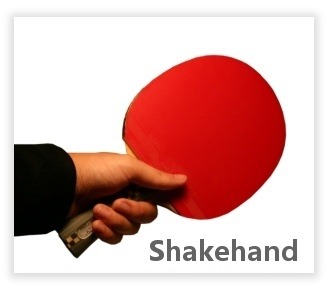
(Shakehand Grip | Source)
In popular Western media, such as television series or movies, people who play ping pong are almost always shown to be holding it with their index fingers on the side of the paddle directly facing the body, and the thumb resting on top of the other fingers which are encircled around the blade handle. This is known as the shakehand grip. It is called a shakehand grip because the blade rests on the V-shape created by one’s thumb and index finger, and save for the other three fingers, this grip will make it look like one is about to shake hands with someone. The index finger should lie roughly parallel with the edge of the rubber at the base of the flat paddle area where one hits the ball. This type of grip is more popular with Western players. Virtually every European player and a majority of Asian players use this grip.
There are two variations of the shakehand grip, shallow and deep. Though in actuality, if one doesn’t look closely, the two look to be about the same. However, the shallow shakehand grip differs from the deep shakehand grip in where the thumb rests. Though this may seem to be a small matter, grip is quite important, and something as seemingly inconsequential as where the thumb rests actually matters. For the shallow shakehand grip, the thumb rests or relaxes on the blade. For the deep shakehand grip, the thumb rests or relaxes on the rubber.
Two Kinds of Shakehand Grip
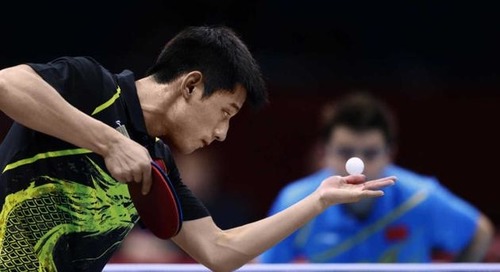
(Sample Shakehand Player: Zhang Jike | Source )
The advantage of the shallow shakehand grip over the deep grip is that it allows for a quicker readjustment of the paddle’s angle, since the grip is loose. This grip will also give one the freedom to move his wrist, and this, in turn, grants the player stronger power and spin when attacking or brushing the ball. This would be effective against short balls that one’s opponent lobbies over.
The advantage of the deep shakehand grip would be that it prevents too much moving of the paddle in the player’s hand, which ensures a firm grasp. This grip does not allow for wrist flexibility, which is good for precisely-controlled strokes that require less power. Both shakehand grips allow for easier movement on either forehand or backhand strokes, since it is easy to switch sides with this kind of grip.
The disadvantage, though, of either shallow or deep shakehand grips is that there will always be a point of indecision that opponents can choose to attack. The point of indecision is also called the crossover point or the playing elbow. Since one holds the paddle in this grip as an extension of the arm, the paddle is positioned in front of the player’s chest, either to the left or to the right depending on the player’s dominant hand, and the elbow is jutted out, leaving a space between underarm and torso. This position ensures that there is a point of indesicion directly in front of the player, since a ball that comes up to the player will force him to decide whether he should sidestep to use his forehand or backhand stroke to counter the ball, since neither forehand nor backhand stroke can be performed optimally if the player does not move from his position.
Shallow shakehand grips are usually held by players who favor topspins, loops, or loop drives, which is when a player lobs the ball over the table by brushing the side or the top of the ball to make the top of the ball go in the same direction as the ball is moving, while the bottom of the ball moves in the opposite direction of the motion of the ball. This type of grip is also favored by players who like smashing, driving, or hitting the ball, which is a stroke that requires medium to fast speed and little to no topspin.
Deep shakehand grips tend to be used by players who favor backspin as a form of attack. The defensive stroke of the players require precise paddle control that only the deep shakehand grip can provide, since it doesn’t require wrist power or wrist flexibility. The defensiveness of this grip also lessens the chances of the player having to attack balls from over the table, which is why wrist flexibility is not an issue for this grip.
Ma Long, who is, as of November 2015, the number one international table tennis men’s player from China, uses a shakehand grip. Fan Zhendong, the second in this rank and also from China, uses a similar grip. Liu Shiwen, Zhu Yuling, and Ding Ning, the rank first, second, and third, respectively, of international table tennis women’s players from China, all use shakehand grips as well. Zhang Jike, currently the fifth best international men’s player, reigning Olympic singles player from China, and fourth male player in the entire history of table tennis to achieve a career grand slam in only 445 days after consecutively winning both the WTTC and the World Cup in 2011 and then the London Olympics in 2012, also favors this type of grip.
People sometimes assume that this is the only way to hold a paddle, but actually, there are many, many more types of grip available for any aspiring beginner to choose from.
The Penhold Grip
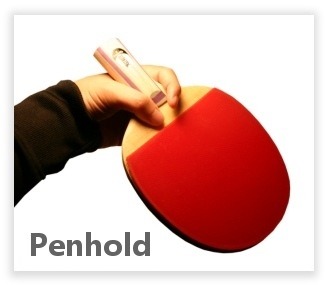
(Sample Penhold Grip | Source)
The second most popular type of grip would be the penhold grip. There are three main versions of this type of grip, namely, the traditional Chinese grip, the Japanese or Korean grip, and the reverse penhold backhand grip. One grips the paddle handle the same way one would grip a pen when one is about to write, with the thumb and index finger in front of the handle, and the remaining three fingers curled slightly around the back of the racket for support.
There are other variations of this grip, where one can hold his thumb nearly parallel to the blade while the index finger is curved. There can be varying gap lengths between the thumb and the index finger. The index finger can slightly overlap with the thumb. The remaining fingers on the back can, either all or some, be touching the blade. The position of the remaining fingers on the back can have varying positions, from the middle or the base of the blade.
The advantage of the traditional Chinese penhold grip is that it allows free movement of the wrist, much more than shakehand grips do. This allows excellent forehand strokes and more power for all types of serves, as well as easier blocking and pushing on the backhand side, wherein the player can either choose to bend his wrist and block it with the forehand side of the blade, or even push the ball with the backhand. Unlike the shakehand grip, there is no crossover point or point of indecision that plagues penhold grip players. The same forehand side is always what the player uses to attack, counter, or defend against any shot.
The disadvantages of this grip is that it proves to be a difficult task to perform consistent backhand topspins, since this will require the player to contort his arm in quite an unnatural degree. It is also less possible for the penhold grip players to reach flexibly either side of the table, which forces penhold style attacking to cover the table with all forehand attacks. This will obviously drain the stamina of the player faster, if, and only if, the player has fast enough footwork to even keep up with the ball in the first place.
Players who use this grip often prefer to stick closer to the table, pushing or blocking with a backhand and attacking with forehand strokes, either through drive or topspin or looping. This variation of the grip is the most popular of all three, favored by Chinese and often making appearances on the international scene.
Other Types of Penhold Grip
The second variation of the penhold is the Japanese or Korean penhold grip. Similar to the traditional Chinese penhold grip, the index and thumb grasp the front of the blade handle as if holding a pen, but the remaining fingers are extended straight out on the blade instead of curled. The two variants of this are whether the ring and pinky finger stick close to the middle finger or whether they are fanned out on the blade.
The advantages of this type of grip adds to the power of attacking on the forehand side, since the extended fingers give support and power to the holder. The grip is good with any forehand strokes, and as the wrist is also very free to move from either left to right or right to left, spinning and serving can be done with a stronger spin.
However, the movement of the blade from the handle to the top of the paddle is somewhat restricted by the extended fingers on the back of the blade, which restricts the adjustment of the angle of the paddle on the backhand side. Like the traditional Chinese penhold grip, it is difficult to perform consistent backhand topspins with this grip, not including professional players who prove that it can be mastered. Similar to the traditional Chinese penhold grip, it requires players to have a large reserve of stamina and fast footwork in order to make up for the poor reach on the backhand side.
Similar to the traditional Chinese grip, this grip is favored by players who prefer to attack with their forehand. Players who use this grip tend to play farther away from the table than the players who use traditional Chinese grips. They use fast topspin loops with their forehand, while blocking or fishing (a heavy topspin stroke used at a medium to far distance from the table and that which usually lobs the ball high over the net) with the backhand. They rely on rapid footwork to hit with their powerful forehand strokes as often as possible in order not to become wholly defensive players. The last few decades prove that there has been a shortage of defending champions who use this type of grip.
The New Kind of Penhold
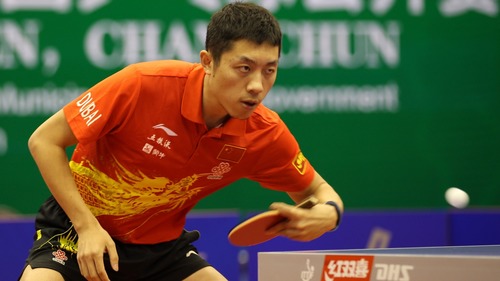
(Sample Penhold Player: Xu Xin | Source)
The last variant of the penhold grip is the reverse penhold backhand grip, where the back of the penhold is used to hit balls that come over to the backhand side of the player. The fingers holding the racket are similar to the traditional Chinese grip. Players using this grip commonly use inverted rubber on their backhand, to produce efficient topspin balls with significantly larger amounts of sidespin, which also comes from the natural movement of the arm and paddle.
The advantages of this type of grip is that while it has the advantages of the traditional Chinese penhold grip, it removes the normal penhold weakness in the backhand, allowing users of this grip the capability to produce heavy topspin backhand strokes with good power and wide reach. This grip also allows users to attack short balls with his backhand, since wrist movement is flexible. Some players use a combination of the traditional Chinese penhold grip and the reverse penhold backhand grip to maximize performance.
However, if the reverse penhold backhand grip is used exclusively from the backhand side, it suffers the same problems as the shakehand grip, where the player will have a crossover point or point of indecision. If the reverse penhold backhand grip is combined with the Chinese penhold push and block strokes, a problem that might occur is that the player must quickly decide which type of stroke among the two to use, and then adjust the paddle accordingly under pressure.
Another limitation of the reverse penhold backhand grip is that it is actually quite difficult to produce topspins on the backhand side that do not have a little sidespin to them. This makes aiming a straight ball from the backhand more difficult than hitting a cross-court ball.
This grip is currently being used by players who prefer to play with heavy topspin on both sides, in other words, players who favor an attacking style. This grip is relatively new, and it might be some time before one can see whether or not this type of grip will become popular.
Penhold grip players are considerably rarer than shakehand grip players, since this grip leaves the backhand with a gaping weakness, a lack of reach on their backhand side. However, this does not mean that it is not common on the international scene. There are several top players who use penhold grips who win World Championships, World Cups, and Olympic games on a regular basis. The backhand weakness can actually be reinforced and backed up by adequately excellent footwork and supplemented with the knowledge and skill of a reverse penhold backhand loop stroke. This style is often most common with players in Asia, most notably, players from Japan, Korea, and of course, China.
Xu Xin, currently the third best international player from China, uses a penhold grip. Wong Chun Ting, currently the eleventh best international men’s player from Hong Kong, also favors this grip. As one can see, it is rarer for this type of grip to be present in international scenes. For the women’s, none of the top ten players use penhold type grips, but Li Jiao, rank 20 from Holland, Ni Xia Lan, rank 58 from Luxembourg, and Lay Jian Fang, rank 137 from Australia, are some of the rare few who prove that it’s possible to use this type of grip and excel at it.
Aside from the shakehand and penhold grips, there are also a few more unusual and infinitesimally rare grips that rarely make it onto international scenes due to their unproven effectiveness in matches. Some examples of this would be the V-grip and the Seemiller grip.
Other Grips
V-Grip
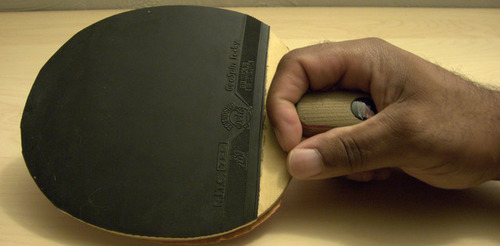
(Sample V-Grip | Source)
The V-grip is when the blade is held between the index and middle finger, spread apart at first to form a letter V. When the blade is in place, the index and middle fingers curl down the blade, gripping it, and the ring and pinky fingers are wrapped around the handle of the paddle. The thumb can be placed wherever it feels most comfortable for the player.
Some of the advantages of this grip, as reported by Tom Veatch when he went to China and first observed this new grip unver development, would be an extended reach, more leverage, and more power and spin in attacking. This grip also allows wide-angled shots and more control.
The disadvantages of this grip are that balls shot towards the player’s elbow are difficult to return without fast footwork, since backhand and forehand strokes overlap and the area of overlapping prove to be even smaller than for the shakehand grip. And as with all unproven grips, it is hard to find a coach who is familiar with this grip enough to teach it. This grip is mainly experimental, and whether or not it will prove to evolve into a majorly popular grip in the future remains to be seen.
Seemiller Grip
Another minor grip is known as the Seemiller grip, made popular by Dan Seemiller, an American player who won five U.S. Men’s Singles Championships, became number one qualifier for the U.S. World Team in 1972, and was once rank 19 on the international scale. It can be observed to be a variation of the shakehand grip, but the tip of the forefinger is placed near the edge of the paddle, or around the edge of the paddle. There is a 90-degree turn so that both thumb and index fingers are grasping either side of the paddle. Most players using this grip will put either put long pimpled rubber or anti rubber on the back, as the combination rubber and occasional twiddling can confuse opponents with their varied returns.
The advantages of this grip would be free wrist movement, allowing strong snaps for forehand topspins, and good for blocking on either forehand or backhand sides. There is no crossover point or point of indecision like for the V-grip or the shakehand grip.
However, disadvantages of this grip would be that backhand side wrist movement is hampered, limiting heavy topspin and powerful returns for the player. Also, ever since table tennis introduced the two-color rule, which states that a player must have either black or red on either side of the blade, the strategy of twiddling the blade with combination rubbers is now less effective, since the opponents can keep track of the rubbers.
The grip is used by players who are mainly attacking style players, who attack with strong forehand topspins and steady backhand returns. Players who use this grip also prefer blocking and countering from either side.
Conclusion
Table tennis is unique among racket sports, since it supports a wide variety of different styles of players, and before a player has a definitive style, there is first the matter of grip. One’s grip should never be tight, merely firm, as to hold the paddle in place. This of course ensures that the player’s grip on the paddle remains constant throughout playing. Other than this, there are no laws in table tennis that prescribe how players should grip their paddles, and hence, there are multiple variations on gripping styles. It would be ideal for a beginner to listen to the advice of his or her coach on what style of grip to use, but sometimes, it would be best to just find a grip one is comfortable with. After all, table tennis is a very individualized sport.

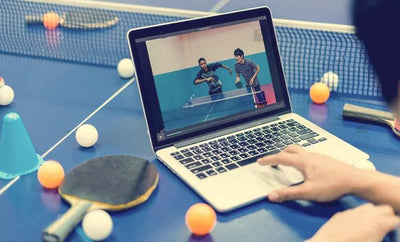


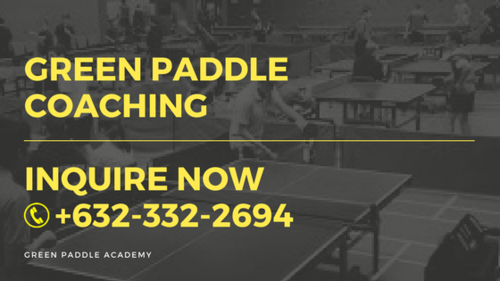
Leave a comment